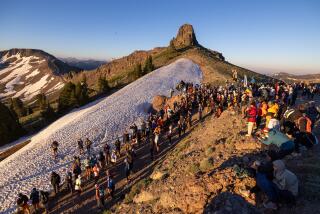Pushing Body and Mind
- Share via
Ultramarathon races begin where marathons end. They range from 50 kilometers (31 miles) to 100 miles and can last 12 or 24 hours. This is not a sport for those of faint breaths or heavy thighs. Training and conditioning can be as arduous as the races, if not more so.
But it is a sport that anyone who is willing to commit to can participate in.
Baz Hawley, a Corona del Mar-based competitor and race director, said ultramarathon racing is a “natural progression” for long distance runners ready to move on from marathons.
“I didn’t start these [ultra races] until I was 35. Most races are broken into several age groups, but there are less people under 30 than over 30,” Hawley said. “The average age in my [last] 100K in Catalina Island was 46.3 years.”
But there are plenty of under-30 runners competing.
For Ben Hian, 29, ultramarathon racing was an outgrowth of his interest in triathlon.
“I did triathlons for a couple of years, and figured if I could do that I could do [ultramarathons],” said Hian, who never raced competitively in high school or college.
Hian, who lives in Encinitas, has been successfully competing in ultramarathon races for eight years.
In April he won the Leona Divide 50 Miler, held at Lake Hughes, Calif., for the fifth consecutive year. His time was 6 hours 41 minutes. He has won the Rocky Raccoon 100-miler the past two years, and is a two-time winner of the Avalon 50 miler.
On Aug. 31, Hian will compete in the Orange 12-hour track run. He holds the event’s distance record of 87.1 miles.
Last year Hian had the fastest 100-mile trail run time in the nation, 13:42:57.
Both men have similar views on how to prepare for races. Each believes even an experienced marathon runner must spend several weeks building endurance and leg strength to handle the increased distances.
“The training is not much different from marathons,” said Hawley, who is organizing races in Yosemite National Park on June 6 and on Catalina Island Sept. 20.
“You increase the number of miles you run, but more important is once a week you run longer, in terms of time on your legs. A marathoner would never run over 20-22 miles in any training run. But an ultra runner may be running five to six hours even if you only cover 25-30 miles. You have to train your mind and your body to keep going.”
Said Hian: “Give yourself time to train your body for the sport. If you’ve never trained for a race, start with a 10K and work up to a marathon. It may take several months, it may take a couple of years. But it depends on how you feel.”
That is why, Hian said, beginners and mid-level runners should build their endurance base gradually, doing moderate mileage for several weeks. When you are capable of running continuously for 2 hours, start adding 15-30 minutes every other week. It is suggested to build up to a five-hour run sometimes before the 50-mile or 100-mile run, allowing for a two-week tapering going into the race.
But Hian also said there is no universal system for training.
“Don’t listen to one person,” Hian said. “Just because something works for me, it may not work for everybody. Look at everyone’s training and pick everyone’s brain.”
Hian trains 100-140 miles a week. On the weekdays he’ll do five to 10 miles, and run 30-40 miles on the weekend. “I train year-round, but if I feel the body needs a break I take a day or two off,” he said.
*
If you don’t feel like running on a certain day, walking, bicycling and weight training are excellent alternatives, Hian said. He lifts a couple of times a week, putting emphasis on high repetitions rather than heavy weights.
Hawley said your body will tell you when you have trained enough.
“Say over the weekend you ran 20 miles one day and then 15 miles the next without soreness and feeling depleted,” Hawley said. That tells you that you are peaking. At the same time, don’t rush into this. If you’re the average marathoner [3:30], you can run a 50K. But you should run a marathon before you run ultra. There is a progression.
“I know people who jump straight into ultras because they’re not interested in marathon. But they still worked up to the mileage.”
Hawley and Hian prefer running hilly mountain trails because it’s easier on the legs, ligaments and tendons than concrete or asphalt.
More to Read
Sign up for The Wild
We’ll help you find the best places to hike, bike and run, as well as the perfect silent spots for meditation and yoga.
You may occasionally receive promotional content from the Los Angeles Times.






